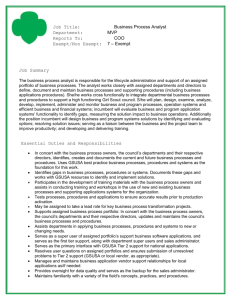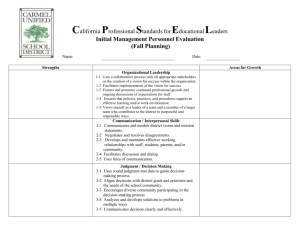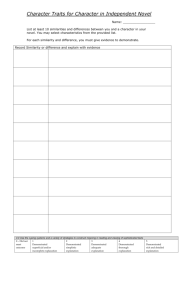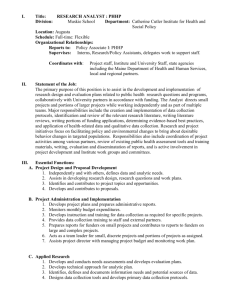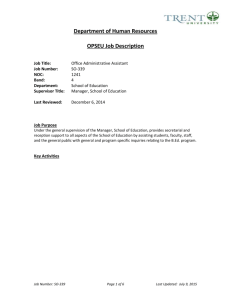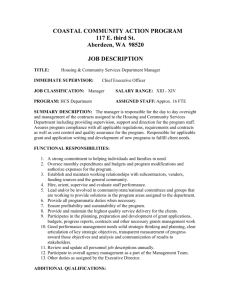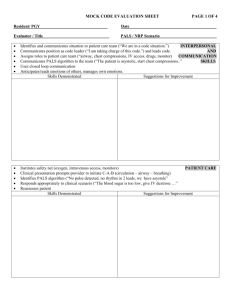HUMAN RESOURCES CONSULTANT
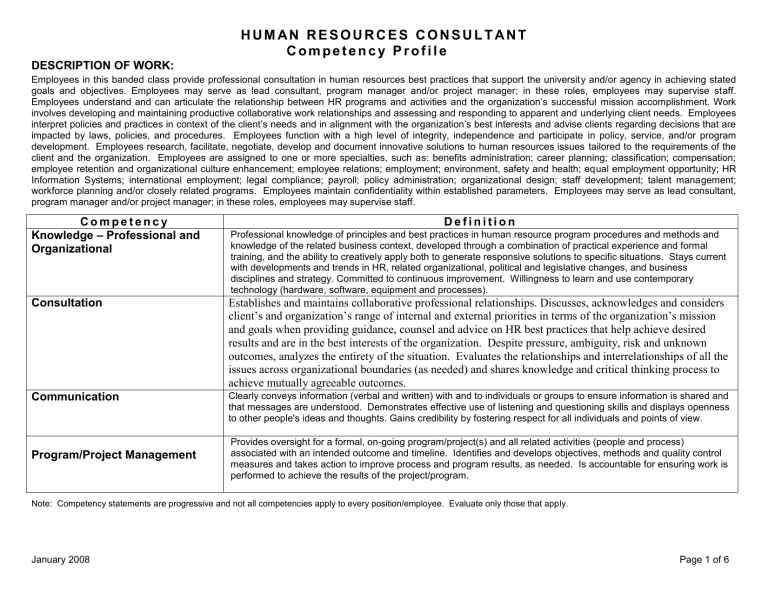
H U M A N R E S O U R C E S C O N S U L T A N T
C o m p e t e n c y P r o f i l e
DESCRIPTION OF WORK:
Employees in this banded class provide professional consultation in human resources best practices that support the universit y and/or agency in achieving stated goals and objectives. Employees may serve as lead consultant, program manager and/or project manager; in these roles, employees may supervise staff.
Employees understand and can articulate the relationship between HR programs and activities and the organization’s successful mission accomplishment. Work involves developing and maintaining productive collaborative work relationships and assessing and responding to apparent and underlying client needs. Employees interpret policies and practices in context of the client’s needs and in alignment with the organization’s best interests and advise clients regarding decisions that are impacted by laws, policies, and procedures. Employees function with a high level of integrity, independence and participate in policy, service, and/or program development. Employees research, facilitate, negotiate, develop and document innovative solutions to human resources issues tailored to the requirements of the client and the organization. Employees are assigned to one or more specialties, such as: benefits administration; career planning; classification; compensation; employee retention and organizational culture enhancement; employee relations; employment; environment, safety and health; equal employment opportunity; HR
Information Systems; international employment; legal compliance; payroll; policy administration; organizational design; staff development; talent management; workforce planning and/or closely related programs. Employees maintain confidentiality within established parameters. Employees may serve as lead consultant, program manager and/or project manager; in these roles, employees may supervise staff.
C o m p e t e n c y
Knowledge
– Professional and
Organizational
D e f i n i t i o n
Professional knowledge of principles and best practices in human resource program procedures and methods and knowledge of the related business context, developed through a combination of practical experience and formal training, and the ability to creatively apply both to generate responsive solutions to specific situations. Stays current with developments and trends in HR, related organizational, political and legislative changes, and business disciplines and strategy. Committed to continuous improvement. Willingness to learn and use contemporary technology (hardware, software, equipment and processes).
Consultation
Establishes and maintains collaborative professional relationships. Discusses, acknowledges and considers client’s and organization’s range of internal and external priorities in terms of the organization’s mission and goals when providing guidance, counsel and advice on HR best practices that help achieve desired results and are in the best interests of the organization. Despite pressure, ambiguity, risk and unknown outcomes, analyzes the entirety of the situation. Evaluates the relationships and interrelationships of all the
Communication
issues across organizational boundaries (as needed) and shares knowledge and critical thinking process to achieve mutually agreeable outcomes.
Clearly conveys information (verbal and written) with and to individuals or groups to ensure information is shared and that messages are understood. Demonstrates effective use of listening and questioning skills and displays openness to other people's ideas and thoughts. Gains credibility by fostering respect for all individuals and points of view.
Program/Project Management
Provides oversight for a formal, on-going program/project(s) and all related activities (people and process) associated with an intended outcome and timeline. Identifies and develops objectives, methods and quality control measures and takes action to improve process and program results, as needed. Is accountable for ensuring work is performed to achieve the results of the project/program.
Note: Competency statements are progressive and not all competencies apply to every position/employee. Evaluate only those that apply.
January 2008 Page 1 of 6
K n o w l e d g e
– P r o f e s s i o n a l a n d O r g a n i z a t i o n a l
Professional knowledge of principles and best practices in human resource program procedures and methods and knowledge of the related business context, developed through a combination of practical experience and formal training, and the ability to creatively apply both to generate responsive solutions to specific situations. Stays current with developments and trends in HR, related organizational, political and legislative changes, and business disciplines and strategy.
Committed to continuous improvement. Willingness to learn and use contemporary technology (hardware, software, equipment and processes).
C o n t r i b u t i n g
1. Knowledge of HR policies and procedures related to assigned area(s), demonstrated by the ability to apply and interpret them for clients while providing services.
2. Knowledge of HR program/service guidelines demonstrated by the ability to identify, evaluate, and resolve recurring work issues.
3. Knowledge of State and federal laws in assigned HR program area(s), demonstrated by the ability to determine the correct or most appropriate course(s) of action.
4. Knowledge of the organization, its mission, its members, its political/legislative climate, its relationships with clients and constituents and the interchange among them.
5. Knowledge of adult learning theory and best practices to organize/conduct routine formal and informal training programs.
6. Knowledge of mathematics, basic statistics, software applications, databases, and related tools pertinent to work functions; produces original queries and reports using that knowledge.
J o u r n e y
1. Knowledge of HR policies, procedures, best practices and their theoretical bases, demonstrated by the ability to apply and interpret a variety of interrelated policies, procedures and programs for clients and address clients’ non-routine issues.
May recommend policy exceptions in programs of assigned area.
2. Knowledge of new HR theories, trends, laws or precedents demonstrated by recommending and implementing improvements or necessary changes to policies, procedures and/or program(s).
3. Knowledge of current thinking in HR theories, best practices, trends, methodologies, laws, and legal precedents, demonstrated by application of same in unusual or unique situations.
4. Knowledge of how internal and external priorities affect organization mission and goals. Incorporate the business’ language when determining alternative solutions for HR issues.
5. Knowledge of theory, practices, and principles of human behavior and learning and the ability to assess specific individual and business needs and develop tailored programs.
6. Knowledge of mathematics, basic statistics, software applications, databases, and related tools to locate, manipulate and analyze data to produce reports that investigate, validate and monitor program/service activity.
A d v a n c e d
1. Knowledge of HR policies, procedures, best practices and their theoretical bases, demonstrated by the ability to relate HR programs to strategic plan to address complex or sensitive issues affecting clients. Collaboratively revises and approves programs, services, policies and/or procedures.
Approves policy exceptions in programs of assigned area.
2. Knowledge of HR area(s) and interaction with other areas demonstrated by the ability to develop and implement new or revised HR systems, policies, and/or procedures. Evaluates and revises policies and programs requiring extensive HR knowledge.
3. Knowledge of current thinking in HR theories, best practices, trends, methodologies and innovations sufficient to develop and retool HR programs and systems to shape and redefine the capabilities of the
HR function to support changing business needs and university strategic goals.
4. Knowledge of relationships and interrelationships of issues across organizational boundaries.
Incorporate the business’ language when designing initiatives that support alignment of strategic business and HR goals.
5. Knowledge of theory, practices, and principles of human behavior and learning; identifies future focused critical capabilities and behaviors and develops organizational and talent management programs necessary for the organization to achieve long-range business goals.
6. Knowledge of efficient ways to capture and analyze information and data, using various tools, systems and programs to meet changing work needs; proposes using alternative methods as appropriate.
January 2008 Page 2 of 6
C o n s u l t a t i o n
Establishes and maintains collaborative professional relationships. Discusses, acknowledges and considers client’s and organization’s range of internal and external priorities in terms of the organizatio n’s mission and goals when providing guidance, counsel and advice on HR best practices that help achieve desired results and are in the best interests of the organization. Despite pressure, ambiguity, risk and unknown outcomes, analyzes the entirety of the situation. Evaluates the relationships and interrelationships of all the issues across organizational boundaries (as needed) and shares knowledge and critical thinking process to achieve mutually agreeable outcomes.
C o n t r i b u t i n g
1. Understands linkage of HR to organizational strategic plan and guides and collaborates with clients to execute routine HR actions and make decisions within the boundaries of established policy and procedure; follows up with colleagues and resource providers to resolve HR issues.
Uses general understanding of client’s organizational issues and work relationships to determine best course of action.
2. Identifies and resolves routine operational issues in assigned HR area(s). Proposes a course of action to address issues.
3. Maintains productive collaborative work relationships and assesses and responds to apparent and underlying client needs; demonstrates effective active listening, questioning and observation skills.
4. Participates in strategic planning for the assigned HR area(s).
5. Consults with clients on a regular basis and reports any issues with program or service effectiveness to supervisor.
J o u r n e y
1. Advises and collaborates with clients to resolve difficult issues in assigned HR area(s); identifies workforce trends; recognizes the impact of policies, procedures, and laws; applies knowledge and understanding of client’s organizational culture, issues and work relationships to address
HR situations; shares knowledge and critical thinking process and promotes the use of best practices to achieve mutually agreeable outcomes in the resolution of HR issues.
2. Determines and documents a course of action to address complex, ambiguous or unique operational and/or programmatic issues in assigned HR area(s).
3. Develops and maintains productive collaborative work relationships in order to facilitate problem resolution with clients; applies ongoing constructive feedback and response skills and techniques through clear communications with clients or assigned staff.
4. Conducts strategic planning for the assigned
HR area(s) and provides input on relationships and interrelationships of all units and ideas to improve outcomes. Performs similar services for clients.
5. Consults with clients to evaluate the effectiveness of program(s) as needed or requested; recommends and/or may implement changes.
A d v a n c e d
1. Advises and negotiates with clients to address dynamic issues which require an in-depth understanding of the client’s organizational culture, issues and work relationships. Resolves complicated, sensitive, or unusual problems of an individual or systemic nature.
2. Guides and coaches clients, co-workers, and/or subordinates in evaluating and resolving the most complex operational issues, often in overlapping HR program areas. Decisions may be precedent-setting.
3. Coaches and leads others in providing effective, responsive, timely consultation services. Enhances collaboration among individuals and groups and builds consensus when dealing with opposing points of view and resolving competing or complex issues. Promotes a high level of integrity among all staff.
4. Recognizes a need for change and constructively challenges conventional thinking by seeking opportunities to lead strategic planning and change management efforts in assigned HR area(s) that support the business need and have sustainable value.
Performs similar services for clients.
5. Evaluates the macro-level effectiveness of programs; redesigns programs and implements program enhancements to meet organizational needs.
January 2008 Page 3 of 6
C o m m u n i c a t i o n
– V e r b a l / W r i t t e n
Clearly conveys information (verbal and written) with and to individuals or groups to ensure information is shared and that m essages are understood.
Demonstrates effective use of listening and questioning skills and displays openness to other people's ideas and thoughts. Gains credibility by fostering respect for all individuals and points of view .
C o n t r i b u t i n g
1. Establishes and maintains productive collaborative professional work relationships with clients and responds promptly and accurately to answer questions within policy and procedure guidelines in assigned HR area(s). Uses concepts and language that are easy for others to understand. Uses active listening to assure mutual understanding through shared information and viewpoints. Presents controversial information; may refer sensitive situations to higher-level HR Consultant or supervisor.
Encourages mutually agreeable resolution.
2. Gathers information, via interviews, surveys or other means, in order to assess client needs.
J o u r n e y
1. Maintains and enhances professional relationships to increase credibility for building support and reaching consensus when explaining and interpreting policies and procedures within assigned HR area(s). Promotes and markets assigned area(s) and persuades clients of the needs and beneficial outcomes of the HR role.
Conveys sensitive information or decisions to clients regardless of the risks involved. Works toward mutual resolutions that are in the best interests of the organization and the unit.
3. Drafts a variety of written communications and presentations in order to request information, respond to client needs, document and report outcomes. Uses correct grammar, punctuation, and spelling in appropriate writing styles and formats.
2. Initiates and leads (verbal or written) dialogue with clients in order to identify issues and solutions, recommend options, and summarize actions needed/taken.
3. Drafts a variety of written communications in order to explain solutions, convey decisions, interpret policy and train/coach. Creates interesting presentations using a variety of media and adapts style and tone to convey meaningful information with different audiences.
A d v a n c e d
1. Cultivates professional relationships with all levels of the organization in order to understand the business case and to have credibility when taking the initiative in difficult situations. Through effective negotiation and persuasion skills, encourages others in complex and sensitive situations to reach a mutually agreeable resolution that achieves business goals and maintains positive work relationships across the organization.
2. Coordinates and manages communication efforts conveying difficult, crucial, and/or controversial decisions/results across organizational lines.
3. Develops communication strategies and approaches necessary to convey complex or controversial information. Drafts communications that inform decisions and influence outcomes.
January 2008 Page 4 of 6
P r o g r a m / P r o j e c t M a n a g e m e n t
Provides oversight for a formal, on-going program/project(s) and all related activities (people and process) associated with an intended outcome and timeline.
Identifies and develops objectives, methods and quality control measures and takes action to improve process and program results, as needed. Is accountable for ensuring work is performed to achieve the results of the project/program.
C o n t r i b u t i n g
1. Administers assigned HR program(s) or project(s) of limited scope and complexity within set parameters.
2. Plans work to meet established objectives and deadlines. Monitors work of others and provides ongoing guidance and feedback to employees on performance. Identifies and clearly communicates with the employee when accomplishments are met as well as the specific areas needing improvement.
3. Provides on-the-job-training for employees helping them to be successful in the work assigned; answers questions in a timely manner.
Considers the audience’s skill level and training needs and delivers basic training programs to meet identified needs.
4. Participates as a member of program/project implementation team(s), supporting and promoting changes.
J o u r n e y
1. Leads HR program(s) or project(s) within established guidelines and standards, or leads a component of a larger program/project. Ensures program/project accountability. Defines scope, goals, tasks, deliverables, timelines, tools, and resources.
2. Assesses the needs of the work unit or project, determines any gaps and recommends changes in procedures, workflow and work assignments to improve efficiency and effectiveness in performance of individuals and the work unit as a whole.
3. Conducts educational and staff development needs assessment and develops educational materials and plans to meet individual, work unit and organizational goals. Designs and delivers interesting training program materials that deliver a meaningful and compelling message to clients.
4. Applies whole system thinking and considers external and internal environmental factors and organizational culture when developing strategies to motivate and persuade management and employees to appreciate, support, and promote changes that result in operational improvement.
A d v a n c e d
1. Manages new or multi-faceted HR program(s) or project(s). Leads and facilitates teams, workgroups or assigned staff; conducts research and development; takes initiative in strategic planning and change management efforts; develops, implements, and evaluates program(s)/project(s).
2. Establishes goals and objectives of program(s)/project(s). Sets appropriate deadlines.
Plans and assigns work of others. Creates a work environment that supports individuals being engaged and committed to the work and the organization.
3. Identifies organizational needs and relevant business improvement processes and designs staff development program curricula that promote greater learning within the organization. Serves as a subject matter expert for new topics and delivers educational sessions for HR practitioners, executive management, and others.
4. May lead program/project implementation team(s), acting as a change agent. Understands organizational culture and vision to anticipate barriers to accepting change, especially when changes have broad impact.
Enhances collaboration and builds consensus across the organization by anticipating opposing points of view and reconciling differences.
Note: Individual employees may manage programs and/or projects and associated staff. This comp etency can be rated combined or separately based on the employee’s assignments.
January 2008 Page 5 of 6
M i n i m u m T r a i n i n g a n d E x p e r i e n c e G u i d e l i n e s :
Graduation from a four-year college or university and two years of progressively responsible experience analyzing, interpreting, applying, communicating and promoting HR best practices in the context of organizational goals and objectives; or an equivalent combination of training and experience. Degrees must be from appropriately accredited institutions.
Special Note:
This is a generalized representation of positions in this class and is not intended to identify essential work functions per ADA. Exam ples of competencies are primarily those of the majority of positions in this class, but may not be applicable to all positions.
January 2008 Page 6 of 6
